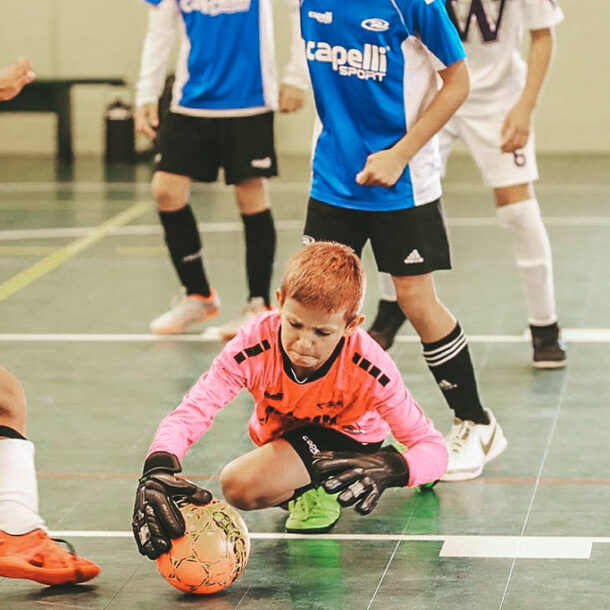
This article was written by Pablo Toledo, Rush Soccer’s Coach & Player Development Director.
One of the things that I find most interesting about the Rush Blue Thread as an instrument to create a great learning environment for our players is that it doesn’t just focus on the ‘what you coach’ but it actually deeply affects the ‘how you coach it’.
One of the elements that has a remarkable effect on the how is the principle that suggests to use visual cues in your coaching points.
What is all of that about?
Scientific studies are showing that decision making (a vital skill for soccer players) is a perception based process, and a very visual one (not exclusive though, there’s also sensory and auditory), and perception is deeply intertwined with experiential knowledge.
Ok, there’s a lot in that paragraph, let me break it down:
- Decision Making Is A Very Perception Based Process: What this means is that we make these quick decisions based on cues or triggers that we mainly visually perceive in our environment. One of the fascinating things about this phenomenon is that most of the time we do it unconsciously. The video below, in which Cristiano Ronaldo’s visual perception while dribbling is analyzed with eye tracking glasses, is just pure gold.
- Perception Is Deeply Intertwined With Experiential Knowledge: In other words, this is saying that what we know helps us narrow our attention to what matters. It’s incredible how this works. The next video, from pianist Daniel Beliavsky and one of his students, shows amazingly how his eyes are actually looking at less things that hers are, and in a very methodical way, something that not even the expert was aware of. The more experience we have, the more complex our mental models, and often, the less aware we become of what we are looking at. It’s important to consider the differences in your own mental models and those of the players you coach. (Hint: they see more and understand less!).
All of this analysis might seem unnecessarily complex but it actually has deep repercussions in the way we coach because it means that, for example, rather than focusing our coaching on ‘what do you do’ we should focus it on ‘what do you see’ and once again it highlights the necessity of presenting specific contexts. How fascinating is that? If we review the video from Cristiano Ronaldo, you’ll notice that the researchers explain that he’s unconsciously looking at the hips, knees and feet of the opponent, and actually looking for space behind to dribble to. Have you ever thought about that? That gives us a great opportunity to exemplify and compare coaching points from a what you do to a what you see perspective: We tend to use these coaching points about dribbling that make little to no sense at all like ‘drop a shoulder’ or ‘change directions’ when in reality there’s no technical fundamentals for the skill dribbling and what really matters is what affects and triggers the decision making for dribbling, you need to see space behind.
Another example can be observed analyzing the nowadays very emphasized act of scanning. If we ask our players to check over the shoulder (scan, scan, constantly scan!) but there’s not a realistic game situation to scan through, the player might develop the habit of doing it mechanically (I like to call this the whiplash effect). However, we are most likely not improving the efficiency of his/her perception and therefore developing his/her decision making skill. Instead we should use phrases such as, “look for the defender behind you” or “check to see if you can see any teammates”. The end result will be not only a player who “checks her shoulder” but also one who knows what he/she is looking for. It is not a coincidence that two other elements of the Rush Blue Thread are about ensuring there is actually a decision to make (Principle: Each activity contains decision making elements) and the context is game specific (Principle: Minimum 75% of the session is game based and opposed). This is, in a big part, another effort to ensure specificity is as high as possible.

Once we teach players what to look for, helping them apply the right solution becomes much simpler. When a coach shouts from the sideline for a center back to drop, the coach has likely recognized a visual cue in the game that suggests a long ball or threat to the space behind. However, if we neglect to emphasize the visual cue with the center back, he will be unlikely to autonomously drop when the game demands it. Adding the cue to the coaching point gives the player the tools to apply the information. A change as simple as, “When the midfielder receives the ball with time and space, you need to drop.”
Not long ago I was watching a conference about transference from small sided games to 11v11 and one of the presenters said something about training activities that I absolutely loved. He said: You have to be careful with expecting transference from small-sided games to the real game, because soccer is played 11v11 with one ball, two full size goals, and in a full size field. Small sided games are not soccer, are not the same game, are small sided games.
So once again, the context needs to be specific for the visual cue to actually be there.
This research presented through the idea of using visual cues also highlights the importance of referring to situations that are recreating the decision making moment and avoiding hypotheses or trying to coach based on having the players remember what happened five minutes ago, as that would be purely based on the subjectivity of the individual (we don’t always remember things exactly how they were, even if they just happened).
Anyway, and to be fair to the real genius behind this, a lot of what we are presenting here are concepts that author Doug Lemov has presented eloquently in his last book The Coach’s Guide To Teaching (we deeply recommend this book).
Please take the time to read this article he posted on his blog.
He also presents on the topic, if you prefer listening than reading, in John O Sullivan’s Way Of Champions Podcast #206. He talks about this as of the 17th minute, but I would deeply encourage you to listen to it all.
Next in the month we’ll try to materialize the learning presented here with a very concrete list of examples and coaching points you can use to ensure the usage of visual cues in your sessions.
Hope this was an enjoyable and interesting article, Coach.









